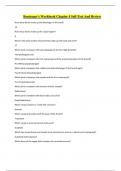Exam (elaborations)
Bontrager's Workbook Chapter 4 Self-Test And Review
- Course
- Institution
Bontrager's Workbook Chapter 4 Self-Test And Review How many bones make up the phalanges of the hand? 14 How many bones make up the carpal region? 8 What is the total number of bones that make up the hand and wrist? 27 Which joint is between the two phalanges of the first digit (thumb...
[Show more]



